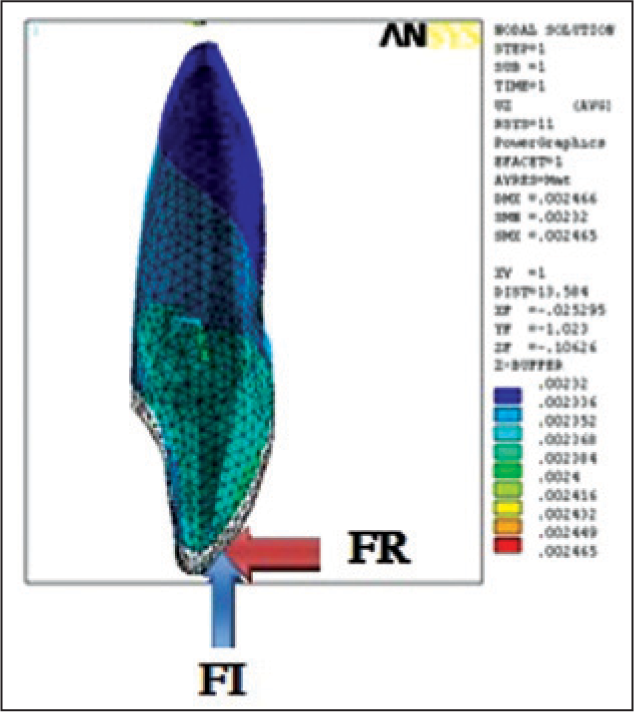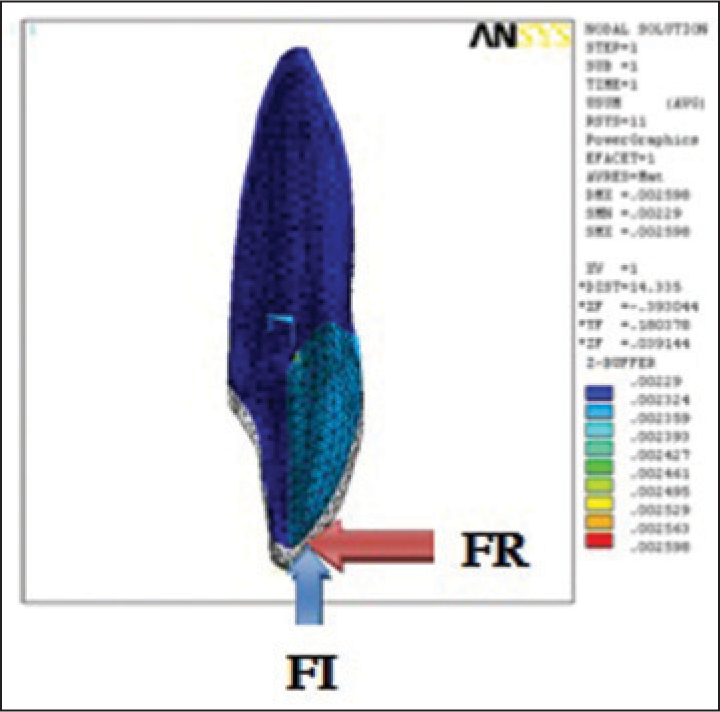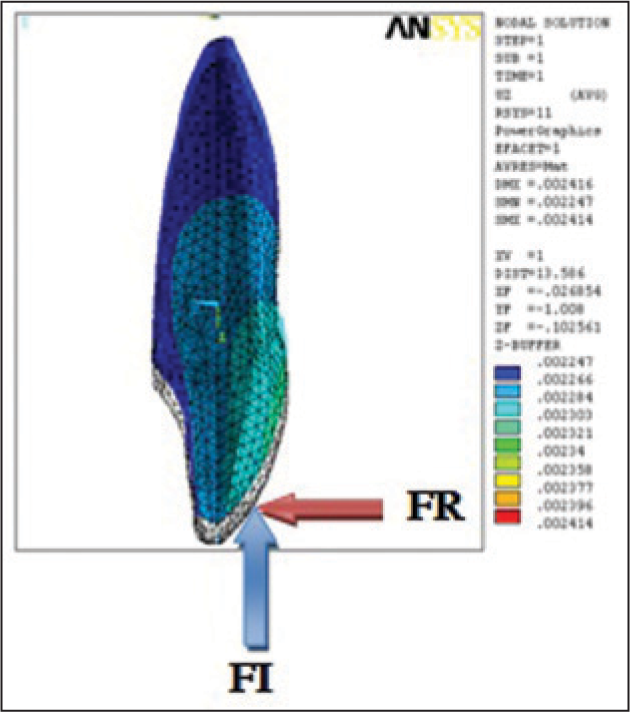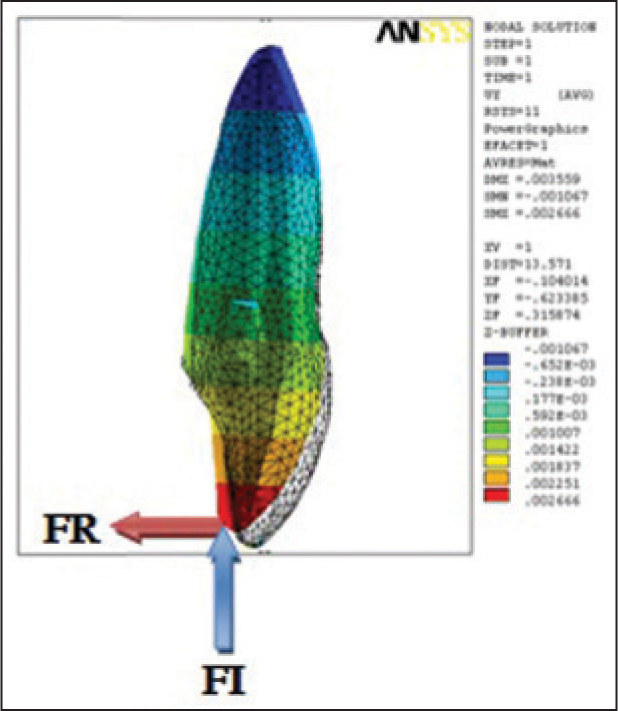Translate this page into:
Effect of intrusive and retraction forces in labial and lingual orthodontics: A finite element study
This article was originally published by Wolters Kluwer and was migrated to Scientific Scholar after the change of Publisher.
Abstract
Objectives
Lingual orthodontics differs in biomechanics as compared to labial system and has biomechanical advantages. Although theoretical approaches have explained the differences between labial and lingual orthodontics, the finite element method (FEM) may be better suited to analyze these differences. This study analyzes the effect of vertical and horizontal forces together on the tooth using FEM.
Materials and Methods
An extracted right maxillary central incisor was radiographed and was used to create a solid model using ANSYS. The geometric model was converted into a finite element model with the help of ANSYS software. The model consists of 27,000 elements and 30,000 nodes. Two force vectors (vertical and horizontal) were applied labially and lingually at 3 different heights-4 mm, 5 mm and 6 mm from the incisal edge.
Results
In the labial system, the net force vector passes through the center of resistance (CR) and brings about intrusion. The net force vector in lingual orthodontics does not pass through the center of resistance and produces lingual tipping of the incisors.
Conclusion
Intrusion and retraction forces bring about tipping of incisors in lingual orthodontics. The same amount of intrusion and retraction forces brings about intrusion of incisors in labial orthodontics. Therefore, direction and amount of forces should be carefully and judiciously applied after taking into consideration the resultant biomechanical differences.
Keywords
Center of resistance
finite element method
intrusion
labial orthodontics
lingual orthodontics
retraction
tipping
INTRODUCTION
Lingual multibracket appliances, besides solving esthetic needs, have biomechanical advantages so far as the point of application of the force in relation to the center of resistance of the tooth is concerned.
Unlike the labial bracket, the lingual bracket has a position closer to the center of resistance of the tooth, thus allowing easier movement whenever a force is applied.
Vectors of orthodontic forces applied to lingual brackets pass lingual to the center of rotation of the teeth, which increases lingual crown torque on the anterior teeth.[1]
Using the labial system, the net force vector is pointed directly towards the centre of resistance (CR), which brings about intrusion.
The net force vector in lingual orthodontics, however produces a lingual tipping and vertical bowing effect, thus the retraction forces should be minimized during an en-masse retraction, and more intrusion and torque forces are needed to retract the anterior using lingual orthodontics.[1,2]
Although theoretical approaches have explained the differences between labial and lingual orthodontics, the finite element method (FEM) is better suited to analyze these differences. This study analyzes the effect of vertical and horizontal forces together on the tooth using FEM.
Finite Element Analysis (FEA) was introduced by R. Courant in 1943. It is a powerful computer simulation tool in solving stress-strain problems in the mechanics of solids structures in engineering. The term “finite element” was coined by Clough in 1960. In orthodontics, FEM has been used successfully to model the application of forces to single and multi-tooth systems, to show the area of bone remodeling, due to various types of tooth movements like tipping, bodily movement, rotation, retraction etc.
MATERIALS AND METHODS
Finite Element Method is an approximation method that divides the entire region of the structure into a set of elements that are connected by points called nodes. Element types are decided, and each element is assigned material properties to represent the physical properties of the model. The forces and boundary conditions are defined to simulate applied loads and constraints of the structure.
Steps involved in the finite element model
An extracted right maxillary central incisor was radiographed and was used to create a solid model using ANSYS software (ANSYS, Inc, Canonsburg, Pennsylvania) is general purpose software, used to simulate interactions of all disciplines of physics. ANSYS can import computer assisted designing (CAD) data and also enables to build geometry with its “preprocessing” abilities. Similarly, in the same preprocessor, finite element model (a.k.a. mesh) which is required for computation is generated. After defining loadings and carrying out analyses, results can be viewed as numerical and graphical.
ANSYS can carry out advanced engineering analyses quickly, safely and practically by its variety of contact algorithms, time-based loading features and non-linear material models. The software used for geometric modeling [Figure 1] was Pro/Engineering (Pro/E) (Parametric Technology Corporation –PTC, founded in May 1985). The geometric model was converted into a finite element model with the help of ANSYS software. A 10-noded tetrahedral solid element with 30 of freedom was used. These elements were connected to adjacent elements with the help of nodes. As there was a variation of thickness of the periodontal ligament, an average thickness of 0.25 mm was assumed and generated around the model of the root. The model consists of 27,000 elements and 30,000 nodes as shown in [Figure 2].

- Solid model of maxillary central incisor

- Finite element model of tooth and periodontium
The mechanical properties of tooth, periodontal ligament and alveolar bone in this study are based on established values used earlier[3] as shown in [Table 1].
| Material | Young’s modulus (N/mm2) | Poisson’s ratio |
|---|---|---|
| Tooth | 2.60E+04 | 0.30 |
| PDL | 6.90×10-1 | 0.45 |
| Alveolar Bone | 1.37×104 | 0.30 |
The boundary conditions, in the finite element model, were defined at all peripheral nodes with 0 degree of freedom in all directions.
COMPARATIVE BIOMECHANICS
The theoretical effects of forces applied both labially and lingually have been explained in the previous literatures.[1,2]
APPLICATION OF FORCES
Two force vectors (vertical and horizontal) were applied labially and lingually at 3 different heights, 4 mm, 5 mm, and 6 mm from the incisal edge. The force vectors represent intrusion and retraction forces each of 100 gms.
RESULTS
Labial
When forces were applied on the labial surface of maxillary central incisor, the resultant vector was passing through the center of resistance, which resulted in intrusion as shown in [Figure 3a], [Figure 4a], [Figure 5a].

- Labial force application at 4 mm with resultant intrusion

- Labial force application at 5 mm with resultant intrusion

- Labial force application at 6 mm with resultant intrusion
Lingual
When forces were applied on the lingual surface of maxillary central incisor, the resultant vector was passing palatal to the center of resistance, which resulted in tipping as shown in [Figure 3b], [Figure 4b], [Figure 5b].

- Lingual force application at 4 mm with resultant tipping

- Lingual force application at 5 mm with resultant tipping

- Lingual force application at 6 mm with resultant tipping
The resultant effect was same (Labial-Intrusion, Lingual-Tipping) when forces were applied at 4 mm, 5 mm, and 6 mm from the incisal edge on the labial and lingual surface [Table 2].
| Different heights of force application | Labial | Lingual |
|---|---|---|
| 4 mm | Intrusion | Tipping |
| 5 mm | Intrusion | Tipping |
| 6 mm | Intrusion | Tipping |
DISCUSSION
When the same amounts of intrusive (FI) and retraction force (FR) were applied in both labial and lingual systems, the results were different.
In the labial system, the net force vector passes through the center of resistance (CR) and brings about intrusion. When forces are applied on the labial side, the net moment was zero. Hence, the net vector passes through the center of resistance, which resulted in intrusion.
The net force vector in lingual orthodontics does not pass through the center of resistance and therefore produces lingual tipping of the incisors. It creates a moment which results in lingual tipping. Therefore, the forces should be minimized and more torque should be incorporated to prevent lingual tipping. More torque forces is needed to retract the anteriors using lingual orthodontics.
Liang W, Rong Q, Lin J, Xu B carried out a similar study using a 3-dimensional finite element model of the maxilla and the maxillary incisors.[4] The model consisted of 98,106 nodes, 71,944 10-node solid elements, and 5236 triangle shell units. Horizontal retraction force, vertical intrusive force and lingual root torque were applied to simulate labial and lingual orthodontic treatment. Then, the distribution of the stress-strain (maximum and minimum principal stresses; maximum and minimum principal strains) in the periodontal ligament, the total displacement, and the vector graph of displacement of the nodes of the maxillary central incisor were analyzed and compared between labial and lingual orthodontics.
The results showed that: Loads of the same magnitude produced translation of the maxillary incisor in labial orthodontics but lingual crown tipping of the same tooth in lingual orthodontics. This suggests that loss of torque control of the maxillary incisors during retraction in extraction cases is more likely in lingual orthodontic treatment. Their conclusion was similar to our study.
Lingual orthodontics should not follow the clinical methods of the labial techniques but should increase lingual root torque and decrease horizontal retraction force adequately to achieve the desired orthodontic results.
Although theoretically comparisons between the labial and lingual mechanics have been explained, there are very few FEM studies analyzing the effects of the intrusive and retraction forces together in labial and lingual systems on the maxillary central incisor. This FEM study validates the theoretical aspect of force vectors and their effects.[1,2,4,5,6]
CONCLUSION
Intrusion and retraction forces bring about tipping of incisors in lingual orthodontics. The same amount of intrusion and retraction forces brings about intrusion of incisors in labial orthodontics. Therefore, direction and amount of forces should be carefully and judiciously applied after taking into consideration the resultant biomechanical differences.
Source of Support:
Nil.
Conflict of Interest:
None declared.
References
- Biomechanics and comparative biomechanics In: Invisible Orthodontics – Current concepts and solutions in lingual orthodontics (1st ed). Germany: Quintessenz Verlags-GmbH; 2003. p. :55-6.
- [Google Scholar]
- Vertical forces in Labial and Lingual Orthodontics applied on Maxillary incisors – A theoretical approach. Angle Orthod. 2009;74:195-201.
- [Google Scholar]
- Stresses induced by edgewise appliances in the periodontal ligament-A finite element study. Angle Orthod. 1992;1:15-22.
- [Google Scholar]
- Torque control of the maxillary incisors in lingual and labial orthodontics-A 3-dimensional finite element analysis. Am J Orthod Dentofacial Orthop. 2009;135:316-22.
- [Google Scholar]
- Biomechanical responses of tooth to orthodontic forces applied at the lingual bracket positions. J Osaka Univ Dent Sch. 1992;32:6-13.
- [Google Scholar]
- A comparative evaluation of different compensating curves in the lingual and labial techniques using 3D FEM. Am J Orthod Dentofacial Orthop. 2003;123:441-50.
- [Google Scholar]






